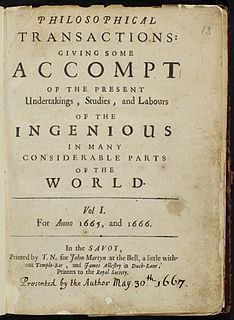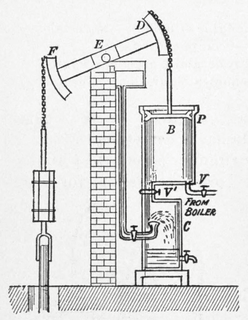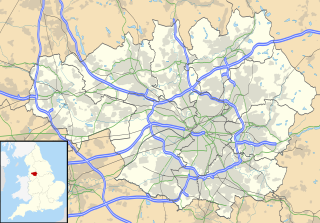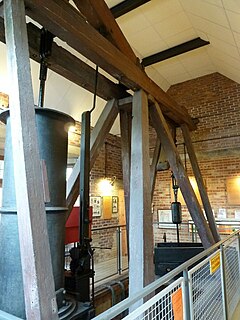Henry Beighton (c. 20 August 1687 – 9 October 1743) was an English engineer and surveyor.
He was born at Chilvers Coton near Nuneaton, Warwickshire and worked in the neighbouring village of Griff. In 1717, he published an engraving of the Newcomen engine erected there in 1714 by Thomas Newcomen. In 1718 he erected one at Oxclose colliery at Washington, County Durham. By measuring the work done by the Griff engine, he was able to compile a table of quantity of water that could be raised by an engine with a six-foot stroke working at 16 strokes per minute. He published this table in The Ladies' Diary which he edited at the time.

Chilvers Coton is an area of the town of Nuneaton in Warwickshire, England, around one mile south of the town centre.

Nuneaton is a town in northern Warwickshire, England. The population in 2011 was 86,552, making it the largest town in Warwickshire.

Warwickshire is a landlocked county in the West Midlands region of England. The county town is Warwick, although the largest town is Nuneaton. The county is famous for being the birthplace of William Shakespeare.
On his return to his native county he made a plane table and prepared a map of the county, which was published in 1728 at a scale of one inch to one mile.
A plane table is a device used in surveying and related disciplines to provide a solid and level surface on which to make field drawings, charts and maps. The early use of the name plain table reflected its simplicity and plainness rather than its flatness.
He was elected as a Fellow of the Royal Society in 1720 and contributed four papers to the Philosophical Transactions of the Royal Society , including a description of his plane table, and of George Sorocold's waterworks at London Bridge. [1]

The President, Council and Fellows of the Royal Society of London for Improving Natural Knowledge, commonly known as the Royal Society, is a learned society. Founded on 28 November 1660, it was granted a royal charter by King Charles II as "The Royal Society". It is the oldest national scientific institution in the world. The society is the United Kingdom's and Commonwealth of Nations' Academy of Sciences and fulfils a number of roles: promoting science and its benefits, recognising excellence in science, supporting outstanding science, providing scientific advice for policy, fostering international and global co-operation, education and public engagement.

Philosophical Transactions, titled Philosophical Transactions of the Royal Society from 1776, is a scientific journal published by the Royal Society. In its earliest days, it was a private venture of the Royal Society's secretary. It became an official society publication in 1752. It was established in 1665, making it the first journal in the world exclusively devoted to science, and therefore also the world's longest-running scientific journal. The use of the word philosophical in the title refers to natural philosophy, which was the equivalent of what would now be generally called science.

George Sorocold was an engineer in Derby, England, in the eighteenth century.
His interest in the working of the Griff engine brought him into contact with J. T. Desaguliers and contributed details and illustrations of hydraulic machines for the second volume of the latter's Course of Experimental Philosophy, eventually published in 1744. This included a description by Beighton of an overshot mill, with an engraving of a corn mill by the abbey in Nuneaton. This is the earliest illustration of a mill where a single waterwheel drove more than one set of machinery. [2]

John Theophilus Desaguliers FRS was a French-born British natural philosopher, clergyman, engineer and freemason who was elected to the Royal Society in 1714 as experimental assistant to Isaac Newton. He had studied at Oxford and later popularized Newtonian theories and their practical applications in public lectures. Desaguliers's most important patron was James Brydges, 1st Duke of Chandos. As a Freemason, Desaguliers was instrumental in the success of the first Grand Lodge in London in the early 1720s and served as its third Grand Master.
His outstanding county map of Warwickshire was one of the first soundly based on trigonometrical survey methods. A remarkably wide range of features is depicted on the map, reflecting the whole life and economy of the county: Parish churches, chapels, depopulated places, seats of nobility, chases, parks, king's houses, monasteries, castles, Roman ways, etc. Beighton's map was well ahead of its time.










